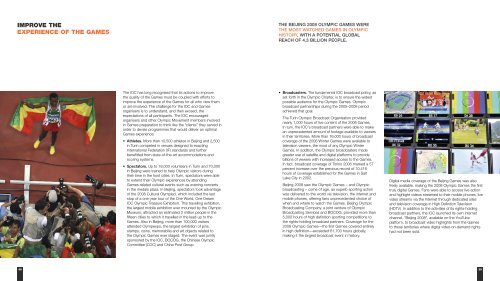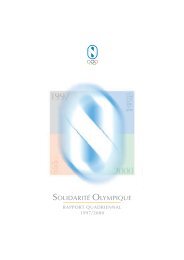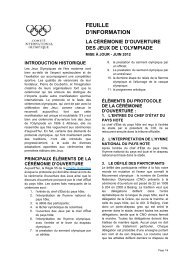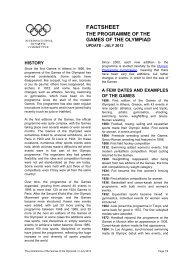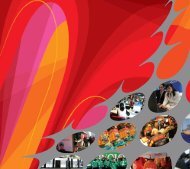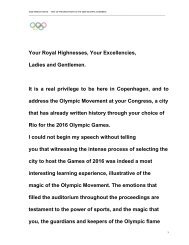3912 reportcomplete final web:layout 1
3912 reportcomplete final web:layout 1
3912 reportcomplete final web:layout 1
Create successful ePaper yourself
Turn your PDF publications into a flip-book with our unique Google optimized e-Paper software.
IMPROVE THE<br />
EXPERIENCE OF THE GAMES<br />
28<br />
The IOC has long recognised that its actions to improve<br />
the quality of the Games must be coupled with efforts to<br />
improve the experience of the Games for all who view them<br />
or are involved. The challenge for the IOC and Games<br />
organisers is to understand, and then exceed, the<br />
expectations of all participants. The IOC encouraged<br />
organisers and other Olympic Movement members involved<br />
in Games preparation to think like the “clients” they served in<br />
order to devise programmes that would deliver an optimal<br />
Games experience:<br />
Athletes. More than 10,500 athletes in Beijing and 2,500<br />
in Turin competed in venues designed to exacting<br />
International Federation (IF) standards and further<br />
benefitted from state-of-the-art accommodations and<br />
scoring systems.<br />
Spectators. Up to 18,000 volunteers in Turin and 70,000<br />
in Beijing were trained to help Olympic visitors during<br />
their time in the host cities. In Turin, spectators were able<br />
to extend their Olympic experiences by attending<br />
Games-related cultural events such as evening concerts<br />
in the medals plaza. In Beijing, spectators took advantage<br />
of the 2008 Cultural Olympiad, which included the last<br />
stop of a one-year tour of the One World, One Dream<br />
IOC Olympic Treasure Exhibition. This travelling exhibition,<br />
the largest mobile exhibition ever mounted by the Olympic<br />
Museum, attracted an estimated 2 million people in the<br />
fifteen cities to which it travelled in the lead-up to the<br />
Games. Also in Beijing, more than 100,000 visitors<br />
attended Olympexpo, the largest exhibition of pins,<br />
stamps, coins, memorabilia and art objects related to<br />
the Olympic Games ever staged. The event was jointly<br />
sponsored by the IOC, BOCOG, the Chinese Olympic<br />
Committee (COC) and China Post Group.<br />
THE BEIJING 2008 OLYMPIC GAMES WERE<br />
THE MOST WATCHED GAMES IN OLYMPIC<br />
HISTORY, WITH A POTENTIAL GLOBAL<br />
REACH OF 4.3 BILLION PEOPLE.<br />
Broadcasters. The fundamental IOC broadcast policy, as<br />
set forth in the Olympic Charter, is to ensure the widest<br />
possible audience for the Olympic Games. Olympic<br />
broadcast partnerships during the 2005–2008 period<br />
achieved that goal.<br />
The Turin Olympic Broadcast Organisation provided<br />
nearly 1,000 hours of live content of the 2006 Games.<br />
In turn, the IOC’s broadcast partners were able to make<br />
an unprecedented amount of footage available to viewers<br />
in their territories. More than 16,000 hours of broadcast<br />
coverage of the 2006 Winter Games were available to<br />
television viewers, the most of any Olympic Winter<br />
Games. In addition, the Olympic broadcasters made<br />
greater use of satellite and digital platforms to provide<br />
billions of viewers with increased access to the Games.<br />
In fact, broadcast coverage of Torino 2006 marked a 57<br />
percent increase over the previous record of 10,416<br />
hours of coverage established for the Games in Salt<br />
Lake City in 2002.<br />
Beijing 2008 saw the Olympic Games – and Olympic<br />
broadcasting – come of age, as superb sporting action<br />
was delivered to the world via television, the internet and<br />
mobile phones, offering fans unprecedented choice of<br />
when and where to watch the Games. Beijing Olympic<br />
Broadcasting Company, a joint venture of Olympic<br />
Broadcasting Services and BOCOG, provided more than<br />
5,000 hours of high definition sporting competitions to<br />
the rights-holding broadcast partners. Coverage for the<br />
2008 Olympic Games—the first Games covered entirely<br />
in high definition—exceeded 61,700 hours globally,<br />
making it the largest broadcast event in history.<br />
Digital media coverage of the Beijing Games was also<br />
freely available, making the 2008 Olympic Games the first<br />
truly digital Games. Fans were able to access live action<br />
and highlight videos streamed to their mobile phones, live<br />
video streams via the Internet through dedicated sites<br />
and television coverage in High Definition Television<br />
(HDTV). In addition to the activities of its rights-holding<br />
broadcast partners, the IOC launched its own internet<br />
channel, "Beijing 2008", available on the YouTube<br />
platform, to broadcast video highlights from the Games<br />
to those territories where digital video-on-demand rights<br />
had not been sold.<br />
29


